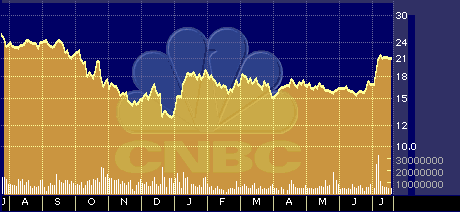
FCC Gives Boost to AT&T’s High-Speed Hopes
FCC Gives Boost to AT&T’s High-Speed Hopes
by Hal Plotkin
Silicon Valley Correspondent
Jul 28 1999 9:11AM ET
Thanks to an assist from the Federal Communications Commission, AT&T’s {T} considerable investments in high-speed information services have a much better chance of paying off.
Recently, the FCC has put its support behind cable companies, indirectly giving a big boost to AT&T and its partner Excite@Home {ATHM} in the competition to sell high-speed cable Internet services to consumers and businesses.The FCC has weighed in on a dispute that erupted earlier this year in several cities, including Portland and San Francisco, over so-called “open Internet access” to cable lines.
AT&T, though its AT&T Broadband and Internet Services unit, has placed heavy bets on cable, spending roughly $120 billion on recent cable acquisitions. AT&T plans to use those lines to offer high-speed Internet access and, in some cases, local telephone services.
The situation began to look dicey for AT&T last month when a federal judge in Portland ruled that AT&T would have to open its cable lines to other Internet service providers, such as America Online {AOL}.
“That would have forced AT&T to wholesale high-speed access to competitors, lose direct access to consumers, and miss out on related e-commerce opportunities,” says Hongjun Li, director of research at Parks Associates, in New York.
While the U.S. Court of Appeals in San Francisco is still hearing AT&T’s appeal in the Portland case, the FCC’s brief in favor of AT&T is considered by many analysts to have dealt a body blow to competing ISPs. “It’s a really a big coup for AT&T,” says Michele Pelino, an Internet analyst at The Yankee Group.
And earlier this week, the San Francisco Board of Supervisors said it will allow AT&T to sell cable services without requiring it to allow competitors equal access to its high-speed, broadband network in the Bay area.

T 52-week price chart
The FCC opposes allowing local jurisdictions to regulate the terms under which cable Internet services can be provided, maintaining that the issue should be decided at the federal level.
In staking out its position, the FCC rebuffed complaints from America Online and other ISPs, that AT&T’s partner, Redwood City, Calif.-based Excite@Home, enjoys a monopoly position as the lone ISP available to consumers through AT&T’s cable lines.
ATHM-488513-6-255-0-260-460-212-FC16D3F430D65B91CF413D8277D39D3F5BA4E5F0.gif” alt=”” />
ATHM 52-week price chart
AT HOME CORP (NNM:ATHM)
| Analyst pinions | Average Recommendation | Earnings Per Share | |||
| Strong Buy | 6 | This Week | 1.6 | Last Quarter | -0.02 |
| Buy | 8 | Surprise | 0.00 | ||
| Hold | 1 | Percent | 0.00% | ||
| Sell | 0 | Consensus EPS | |||
| Strong Sell | 0 | This Year’s | -0.05 | ||
| Next Year’s | 0.16 | ||||
AT HOME CORP – ATHM ranks 84 out of 99. It is in the Internet industry.
Analyst Ratings compiled by Zacks
In his recent statement, FCC Chairman William Kennard supported those who note that the total number of cable modem customers is still quite small and that consumers already enjoy a variety of other options for high-speed Internet access, including wireless, satellite and DSL services offered by telephone companies.
Assuming the FCC’s position is upheld, which seems likely, AT&T will enjoy a significant head start on competitors seeking to reach consumers through high-speed cable lines.
In terms of raw numbers, that means AT&T will have exclusive high-speed cable access to as many as 25 million homes once the company completes its current round of cable acquisitions.
This development is particularly bad news for AOL, which will still be able to reach many, but not all, of those same consumers via competing high-speed transmission channels, such as xDSL, wireless, and satellite.
http://plotkin.com/wp-content/uploads/2015/02/GR-D-IBM-531394-6-255-0-260-460-212-401B01E2929D154C3A122C03A7D1ABC939F335761.gif
AOL 52-week price chart
Projections for the overall growth of the high-speed cable market are all over the map.
The Yankee Group, for example, forecasts 3 million residential cable customers by 2001. In contrast, a February 1999 report from Forrester Research places the number of residential cable lines at 9.2 million by 2001. Jupiter Communications puts the 2001 number at 4.9 million, while Parks Associates places it at 3.9 million.
“The one thing everyone agrees on is that this is going to be a fast-growing market,” says Brian Hammond, senior editor at Telecommunications Reports, a trade journal. In 1998, most analysts agree there were only about 500,000 cable modems in operation.
Even so, Excite@Home and AT&T still have some significant hurdles to jump before the growth of the cable Internet access market meets even the least ambitious projections.
Some of the Excite@Home’s first customers in the San Francisco Bay Area, for example, have complained that promised speeds are not being delivered. In response, Excite@Home has acknowledged that it has reduced the speed at which customers can upload information to the Internet to compensate for higher-than-expected use of the service.
The transmission speed problem is an inherent part of current cable modem technology, which is adversely affected by the number of people using the system in a given local area.
In response, AT&T has promised a massive and speedy upgrade of its cable plant and facilities. That move makes even more sense now that it seems likely AT&T, and not its competitors, will be the primary beneficiary of such investments.


